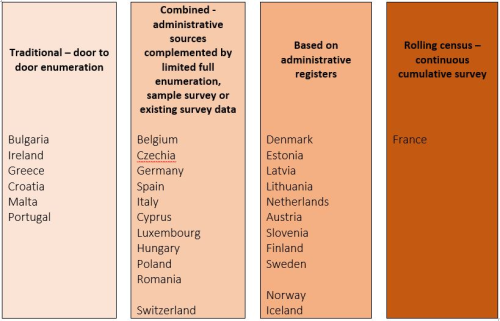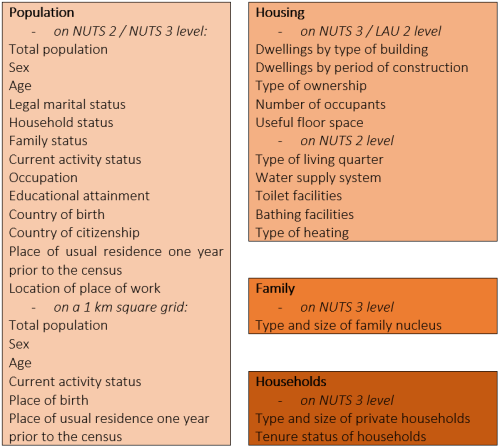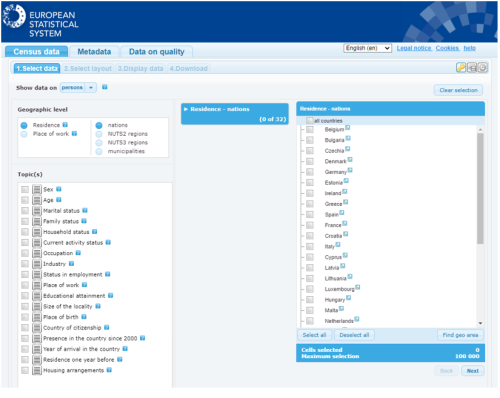Population and housing census 2021 – overview
Highlights
Introduction: What is a population and housing census?
Typically, every 10 years, a census counts the entire population and housing stock of a given country and collects information on its main characteristics (geographic, demographic, social and economic, plus household and family characteristics). They are a snapshot of our society at a given moment in time.
Population and housing censuses provide a precise and geographically detailed count of the population in a country. The census is a rich source of statistical information, ranging from the lowest geographical divisions, covering small areas, to the national and international levels.
They offer information about a wide range of population characteristics with very detailed cross-classifications. This makes them an excellent source for in-depth and flexible analysis. Censuses provide essential statistical input for formulating and evaluating policies, for administration and for research. By laying the foundation for population estimates, sampling and geographical data collections, population and housing censuses are the backbone of social and regional statistics.
Population and housing censuses in the EU are based on European statistical legislation that sets out key statistical definitions and the data and metadata to be produced by EU countries.
Full article
Features of EU censuses
The EU legislation on population and housing censuses is ‘output-oriented’. This means that the authority and responsibility to develop appropriate census methods and technology remain with the Member States, who are free to assess for themselves how to conduct their censuses and which data sources, methods and technology are best for their country. This gives them flexibility, in line with the principles of subsidiarity and of cost effectiveness and with the competences of their statistical office.
Some countries carry out traditional fieldwork employing enumerators to collect census data. This may or may not be complemented with technologies such as using laptops or tablets connected to the database to avoid using paper questionnaires, telephone interviews or online self-enumeration.
Other countries have developed statistical registers that they update regularly to avoid the costly fieldwork caused by census taking, while others use a combination of the two approaches: obtaining part of the data from registers, but still carrying out limited surveys.
The tendency in Europe for most countries is to move away from the traditional census towards the register-based system. EU legislation aims to provide census data that are comparable between the EU Member States. To achieve this, the data have to follow a European programme of statistical data and metadata.
Population and housing censuses make it possible for policy makers to compare different groups of people across the EU and to have detailed information on the housing stock and housing situation of people and families The results of the census, in addition to various economic and social indicators, help determine how funds and support to Member States, regions and communities are allocated, for example for schools, hospitals, roads and public works.
History of the population and housing censuses in the EU
In Europe, from the beginning of the 19th century, population censuses of a statistical nature were held more or less regularly. By the time of the creation of the European Economic Community in 1957, its Member States were carrying out population censuses, although not in a harmonised way.
The 1981 round of population and housing censuses was the first one which was loosely harmonised at EU level by a directive, outlining basic data to be sent to Eurostat. From the 1991 EU census round, these data are available in Eurostat’s online database. European censuses became better harmonised for the 2011 round, by adopting Regulation (EC) No 763/2008, which establishes common rules for the decennial provision of comprehensive data on population and housing. It was also at this time that the Census Hub, an innovative tool for the dissemination of census data, was created.
The 2021 round of population and housing censuses is still based on this framework regulation, with three implementing acts to cover the specificities of data provision. A major innovation is the collection of selected variables on a 1km square grid. Further improvement in the coverage, timeliness and frequency of European population and census data is expected from 2025 with a new framework regulation which is in the process of being drafted and discussed in the European Statistical System.
Legal basis for the 2021 population and housing censuses
The content of the EU census programme serves major policy needs of the EU. To produce census data, the EU Member States have developed different methods that they consider to be best suited to the administrative practices and traditions of their country. The EU legislation upholds this diversity: the framework Regulation (EC) No 763/2008 of the European Parliament and of the Council on population and housing censuses is concerned with output harmonisation rather than input harmonisation. Member States are free to assess for themselves how to conduct their 2021 censuses and which data sources, methods and technology are best for their country. This gives the Member States flexibility, in line with the principles of subsidiarity and of cost effectiveness, and in line with the competences of the statistical offices in the Member States.
However, certain conditions must be met to achieve the objective of comparability of census data from different Member States and to assess data quality. The following figure gives a general overview of the legal basis of the 2021 population and housing censuses in the EU.
Impact of the Covid-19 pandemic on the preparation and the implementation of the 2021 census
Under Commission Regulation (EU) 2017/712, Member States must set a reference date for the census that falls during 2021. However, due to unforeseen circumstances arising from the pandemic, some countries had to postpone the census operation. In some cases the census had been postponed from the date originally planned but still took place in 2021, while in three Member States all or part of the census data collection had to be moved to a date in 2022. However, these three Member States will work to adjust or model the data back to correspond to a reference date in 2021, thereby complying with the EU census legislation.
Some countries faced problems such as mobility restrictions, difficulties in distributing census equipment and organising training events for census staff, or authorities not allowing census activities during the pandemic period. Indeed, the main difficulties appeared to relate to the changes that countries have had to make – often at short notice – to the previously planned census activities. There appeared to be a negligible impact of the pandemic for those countries using only administrative data for censuses. In countries that make use of a ‘traditional’ full census enumeration, the introduction of newer methods such as online internet response and post out/post back of paper census forms limited the disruption due to the pandemic.
Statistical output of the 2021 EU census programme
As stipulated by the EU census legislation described above, Member States have to provide data to Eurostat in two phases:
- Data on total population on a 1km square grid: by 31 December 2022
- All other census data: by 31 March 2024
Dissemination of census data
In the past, census results were to be found mainly in libraries in the form of tables in books. Today, electronic databases offer a more convenient option for users. The results of the last two censuses were solely published electronically both at national and EU level.
Census data for 2021 are published according to the release schedule above using three dissemination channels maintained by Eurostat:
The Census Hub is the main tool where data of the 2021 population and housing census in the EU can be found; information is uploaded as soon as it becomes available in each EU Member State.
The data must be kept in the Census Hub for at least until 1 January 2035, due to the importance of the statistical information. After this time, data will continue to be available in the Eurostat database.
Shortly after the final data provision deadline of 31 March 2024, all the data will also be available in the Eurostat database. In March 2023, georeferenced data to a 1km square grid will be available in the GISCO website section.
Statistical confidentiality of 2021 census results
Statistical confidentiality is a fundamental principle of official statistics enshrined in the Treaties, in EU and national laws and in the European Statistics Code of Practice. Harmonisation of principles and guidelines on the protection of confidential data is an obligation of Eurostat and of national statistical authorities in the European Statistical System.
Statistical disclosure control techniques include different measures applied to the data to eliminate or reduce the risk of disclosing information on individual statistical units (for instance individual persons). Therefore, no information on identifiable individual persons can be derived from the tables.
To this end, Member States must suppress any numerical information if they think this is necessary to protect the statistical confidentiality of the data. For example, Regulation (EU) 2017/712 stipulates that Member States must replace a numerical cell value by the special value ‘not available’ if the numerical cell value must not be disclosed to protect the statistical confidentiality of the data in accordance with the Member States’ statistical disclosure control. Moreover, each affected cell must be flagged as ‘confidential’.
This is to make sure that no confidential information is transmitted to Eurostat under the 2021 EU census legislation, following the same standard as for the 2011 EU census round. However, suppression of confidential values is just one possibility for protecting such information. It is less efficient than other methods, especially in high-dimensional tabulations (hypercubes) where many more non-confidential values must often be suppressed to protect confidential values from disclosure by differencing. Thus, based on the 2011 census experience, and the results of a dedicated project hosted by Eurostat in 2016-17, two specific protection methods, were recommended.
- Record swapping: households containing at least one high-risk person are identified and swapped with similar, low-risk households (the geographic location of the paired households is exchanged, in other words it is a pretabular method acting directly on the microdata before aggregating output tables).
- Cell key method: random noise (±1, ±2, and so on) is added to some cell values in the output tables in a deterministic and unbiased way following a predefined probability distribution (post-tabular method acting on the output tables).
These two methods can be applied either separately or in combination, and Member States were encouraged to use them for the 2021 EU census round.
Metadata and quality assurance
According to the EU legislation, Member States must transmit census metadata within 27 months from the end of the reference period, in other words by the end of March 2024. Member States must report to Eurostat the definitions of the topics used in their censuses; the source of these definitions; the method used to estimate data on the topics; or the reason for any systematic unreliability of the data. This is especially important as Member States are free to choose the data sources and census methodology that best fit their respective national scenarios, but the statistical output must meet some well-defined quality targets.
The metadata and the information on data quality associated with the 2021 census are of two kinds:
- Quantitative metadata: a numeric assessment of different dimensions related to data quality, such as accuracy, completeness, coherence and so on.
- Qualitative, or textual, metadata: a structured set of textual information to explain the methodology used to produce census data (including those cases where different data sources have been combined to obtain the desired statistical output) plus any other generic information useful to complement the actual data.
The EU legislation also stipulates that the 2021 census data must be available in a predefined format (SDMX – Statistical Data and Metadata eXchange) and that the Member States must use the data structure definitions provided by Eurostat.
Context
The EU has been going through a period of demographic and societal change. More information of the work of the European Commission 2019-2024 to tackle the impact of demographic change in Europe can be found in the European Commission dedicated pages.
Population and housing censuses provide essential statistical input for formulating and evaluating policies, for administration and for research. A common programme of comparable census data throughout the EU not only supports EU-wide activities but also make it easier for local policy makers acting at national (or even regional) level to see their situation as part of the larger European picture. The EU programme for the 2021 population and housing censuses has been considerably revised when compared with the 2011 case. The aim of this revision was to simplify and reduce the size of the data to be transmitted, while at the same time keeping up with major policy needs of the EU.
The census results on NUTS 2, NUTS 3 and LAU 2 level, and the selected variables on 1 km² grid level feed into the EU’s regional cohesion policies, which cover large budget items (for example Structural Funds) and require detailed data to evaluate progress in the regions. Moreover, many politically relevant phenomena have a strong regional component, such as the demographic ageing of societies or economic and employment-related developments. The significantly increased demand for geographically very detailed data is specifically addressed with the 1 km² grid dataset.
Direct access to
Publications
Legislation
- European Parliament and Council Regulation (EC) No 763/2008 on population and housing censuses
- Commission Implementing Regulation (EU) 2018/1799 of 21 November 2018 on the establishment of a temporary direct statistical action for the dissemination of selected topics of the 2021 population and housing census geocoded to a 1 km² grid
- Commission Implementing Regulation (EU) 2017/881 of 23 May 2017 implementing Regulation (EC) No 763/2008 of the European Parliament and of the Council on population and housing censuses, as regards the modalities and structure of the quality reports and the technical format for data transmission, and amending Regulation (EU) No 1151/2010
- Commission Regulation (EU) 2017/712 of 20 April 2017 establishing the reference year and the programme of the statistical data and metadata for population and housing censuses provided for by Regulation (EC) No 763/2008 of the European Parliament and of the Council
- Commission Implementing Regulation (EU) 2017/543 of 22 March 2017 laying down rules for the application of Regulation (EC) No 763/2008 of the European Parliament and of the Council on population and housing censuses as regards the technical specifications of the topics and of their breakdowns




